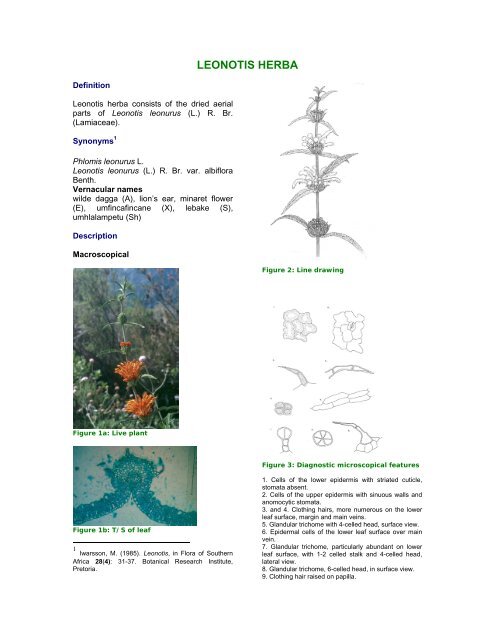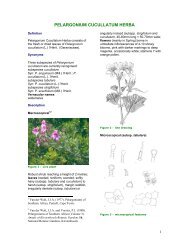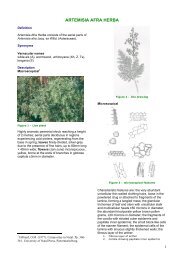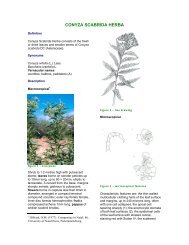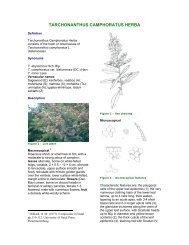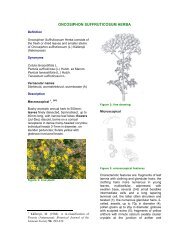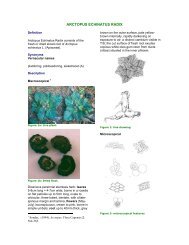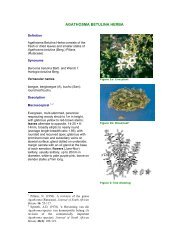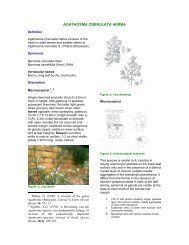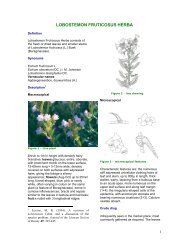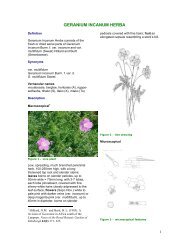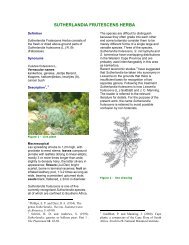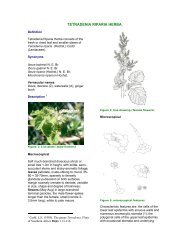LEONOTIS HERBA - PlantZAfrica
LEONOTIS HERBA - PlantZAfrica
LEONOTIS HERBA - PlantZAfrica
Create successful ePaper yourself
Turn your PDF publications into a flip-book with our unique Google optimized e-Paper software.
Definition<br />
Leonotis herba consists of the dried aerial<br />
parts of Leonotis leonurus (L.) R. Br.<br />
(Lamiaceae).<br />
Synonyms 1<br />
Phlomis leonurus L.<br />
Leonotis leonurus (L.) R. Br. var. albiflora<br />
Benth.<br />
Vernacular names<br />
wilde dagga (A), lion’s ear, minaret flower<br />
(E), umfincafincane (X), lebake (S),<br />
umhlalampetu (Sh)<br />
Description<br />
Macroscopical<br />
Figure 1a: Live plant<br />
Figure 1b: T/S of leaf<br />
1 Iwarsson, M. (1985). Leonotis, in Flora of Southern<br />
Africa 28(4): 31-37. Botanical Research Institute,<br />
Pretoria.<br />
<strong>LEONOTIS</strong> <strong>HERBA</strong><br />
Figure 2: Line drawing<br />
Figure 3: Diagnostic microscopical features<br />
1. Cells of the lower epidermis with striated cuticle,<br />
stomata absent.<br />
2. Cells of the upper epidermis with sinuous walls and<br />
anomocytic stomata.<br />
3. and 4. Clothing hairs, more numerous on the lower<br />
leaf surface, margin and main veins.<br />
5. Glandular trichome with 4-celled head, surface view.<br />
6. Epidermal cells of the lower leaf surface over main<br />
vein.<br />
7. Glandular trichome, particularly abundant on lower<br />
leaf surface, with 1-2 celled stalk and 4-celled head,<br />
lateral view.<br />
8. Glandular trichome, 6-celled head, in surface view.<br />
9. Clothing hair raised on papilla.
Shrub 2-5 m tall, branching from a thick<br />
woody base; stem pale brown and densely<br />
pubescent; leaves simple, opposite,<br />
petiolate, coriaceous, 50-100 × 10-20 mm,<br />
linear, acute at apex and base, serrate in the<br />
distal half; upper surface bright green, lower<br />
surface densely pubescent; inflorescence of<br />
3-11 compact verticils; calyx 12-16 mm<br />
long, 4 mm in diameter, calyx teeth 10,<br />
subequal, spreading; corolla tubular, bright<br />
orange, 40-49 mm long, covered with<br />
orange hairs; fruit a nutlet 5-6 ×1.5-2 mm,<br />
brown.<br />
Microscopical<br />
Characteristic features are: the numerous<br />
uniseriate, curved, thick-walled, warty, 2-3<br />
celled non-glandular trichomes of leaf and<br />
stem, 60-100 µm in length, particularly<br />
abundant on margin of lamina and main<br />
veins of lower leaf surface; the numerous<br />
glandular hairs of leaf and stem, with<br />
unicellular stalk and 4-celled head (up to 20<br />
µm in diameter) and yellow-brown contents;<br />
the less numerous glandular trichomes of<br />
leaf lamina, with unicellular stalk and 6-8<br />
celled head, thick-walled, head about 40 µm<br />
in diameter; cells of the lower epidermis with<br />
sinuous walls and striated cuticle, lacking<br />
stomata; cells of the upper epidermis with<br />
sinuous walls and numerous raised<br />
anomocytic stomata; single palisade layer;<br />
abundant crystal sand in cells of the<br />
mesophyll; occasional yellow hairs of the<br />
corolla.<br />
Crude drug<br />
Supplied in bundles comprising young leafy<br />
twigs, the leaves having a characteristic<br />
aromatic-pungent odour, bright yellow-green<br />
colour and rough texture; occasional flowers<br />
and fruits are present.<br />
Geographical distribution<br />
Locally common at forest margins, on rocky<br />
hillsides and river banks and in tall<br />
grassland of the Eastern and Western Cape<br />
Provinces, KwaZulu-Natal and Mpumalanga.<br />
Figure 4: Distribution map<br />
Quality standards<br />
Identity test:<br />
Thin layer chromatography on silica gel<br />
using as solvent a mixture of toluene:diethyl<br />
ether:1.75m acetic acid (1:1:1). Reference<br />
compound: thymol (0, 1% in chloroform).<br />
Method according to Appendix A.<br />
Figure 5: TLC plate<br />
Major compounds:<br />
yellow-mustard (Rf :0,19); yellow-mustard<br />
(Rf: 0,38); blue-mauve (Rf: 0,4); thymol<br />
(pink): Rf:0,8.
Figure 6a: MeOH HPLC Spectrum<br />
Figure 6b: DCM HPLC Spectrum<br />
HPLC on C18 column, method according to<br />
Appendix 2b.<br />
Major compounds:<br />
Methanol extract: (figure 6a)<br />
Retention times (mins): 2,56; 19,46; 20,64;<br />
23,83; 24,92.<br />
DCM Extract: (figure 6b)<br />
Retention times (mins): 2,17; 3,24; 4,06;<br />
10,14.<br />
Ethanol (70%) extractive value: not less<br />
than 22%.<br />
Volatile oil content: not less than 0, 15%<br />
(0, 15-0, 18%).<br />
Purity tests<br />
Assay<br />
Major chemical constituents 2<br />
1. Diterpenoid labdane lactones:<br />
premarrubiin 0.00933-0.01567%, marrubiin<br />
(possibly an artifact derived from<br />
premarrubiin during extraction)<br />
2. Tannins, quinones, saponins, alkaloids<br />
and triterpene steroids were detected in<br />
preliminary tests in our laboratories; iridoids<br />
were not detected.<br />
Figure 6: chemical constituents<br />
Dosage forms<br />
Used mainly in the form of an aqueous<br />
decoction, orally, per rectum and as a<br />
topical application.<br />
Medicinal uses (traditional)<br />
Internal<br />
For the treatment of cough, cold, influenza,<br />
chest infections, diabetes, hypertension,<br />
eczema, epilepsy, delayed menstruation,<br />
intestinal worms, constipation, spider bites<br />
and scorpion stings and as an antidote for<br />
snakebite.<br />
External<br />
For the relief of haemorrhoids, eczema, skin<br />
rashes and boils.<br />
Pharmacology/bioactivity<br />
Anti-nematodal activity has been<br />
demonstrated in vitro against<br />
Caenorhabditis elegans for aqueous and<br />
2 Laonigro, G., Lanzetta, R., Parrilli, M.,<br />
Adolfini, M. and Mangoni, L. (1979). The<br />
configuration of the diterpene spiroethers from<br />
Marrubium vulgare and from Leonotis leonurus.<br />
Gazetta Chimica Italia 109 (3/4): 145-150.
100% ethanol extracts of the dried aerial<br />
parts of South African plants, at<br />
concentrations of 1.0mg/ml. A hexane<br />
extract proved inactive at a concentration of<br />
2.0mg/ml. 3 The same study found water and<br />
ethanol extracts to be inactive in an in vitro<br />
assay for anti-amoebic activity.<br />
Molluscicidal activity of 80% ethanolic<br />
extracts of dried leaf, stem and fruits of<br />
Sudanese plants against Biomphalaria<br />
pfeifferi and Bulinus truncatus could not be<br />
demonstrated in vitro (concentration<br />
200mg/litre) 4 .<br />
Anticonvulsant activity of an aqueous extract<br />
of dried leaf has been demonstrated in vivo<br />
in the mouse (dose: 200.0mg/kg IP) 5 . In an<br />
in vitro assay for antiphage activity of<br />
aqueous fresh leaf+stem extracts of Greek<br />
plants, no activity was demonstrated against<br />
Bacteriophages MS2, PHI-CHI-174, T-7, T2,<br />
T4 or Bacteriophage-OPS7 6 . Extracts of<br />
shade-dried roots of Ethiopian plants were<br />
examined for anti-fertility activity in the rat,<br />
both in vitro (uterine stimulant activity) and in<br />
vivo (anti-implantation effects). Weak uterine<br />
stimulant activity was shown for 95%<br />
ethanol extracts but not for aqueous or nbutanol<br />
extracts (conc. 2.0%). Antiimplantation<br />
activity was shown by both nbutanol<br />
and ethanolic axtracts but not by<br />
aqueous extracts (dose: 0,93g/kg<br />
intragastrically) 7 .<br />
3 McGaw, L.J., Jager, A.K. and van Staden, J.V.<br />
( 2000). Antribacterial, anthelmintic and antiamoebic<br />
activity of South African medicinal<br />
plants. Journal of Ethnopharmacology 72(1/2):<br />
247-263.<br />
4 Abdel-Aziz, A., Brain, K. and Bashir, A.K.<br />
(1990). Screening of Sudanese plants for<br />
molluscicidal activity and identification of leaves<br />
of Tacca leontopetaloides (L.) O. Ktze<br />
(Taccaceae) as a potential new exploitable<br />
resource. Phytotherapy Research 4(2): 62-65.<br />
5 Bienvenu, E., Amabeoku, G.J., Eagles, P.,<br />
Scott, G. and Springfield, E.P. (2002).<br />
Anticonvulsant activity of aqueous extract of<br />
Leonotis leonurus (Lamiaceae). Phytomedicine<br />
217(2): 217-223.<br />
6 Yannitsaros, A. (1996). Screening for antiphage<br />
activity of plants growing in Greece. Fitoterapia<br />
67(3): 205-214.<br />
7 Desta, B. (1994). Ethiopian traditional herbal<br />
drugs. Part III: anti-fertility activity of 70<br />
Brine shrimp lethality assay: preliminary<br />
results showed no effect on brine shrimps in<br />
the concentrations tested.<br />
Antimicrobial activity assay<br />
No in vitro antimicrobial activity of aqueous<br />
extracts of South African collections of L.<br />
leonurus against Pseudomonas aeruginosa,<br />
Candida albicans, Staphylococcus aureus or<br />
Mycobacterium smegmatis was observed, in<br />
the concentrations used for disc assays in<br />
our laboratories.<br />
Contraindications<br />
Not recommended for use by pregnant<br />
women.<br />
Adverse reactions<br />
First time users may experience dizziness,<br />
nausea or sweating.<br />
Precautions<br />
Treatment should be continued for one<br />
week. If symptoms persist, additional or<br />
alternative therapy should be sought. The<br />
use of this herb to treat diabetes,<br />
hypertension epilepsy or snakebite cannot at<br />
this stage be recommended, owing to lack of<br />
clinical data.<br />
Dosage<br />
1 tablespoonful of chopped dried herb<br />
(±10,0g) added to 3 cupfuls (±500ml) of<br />
boiling water, boil for 10 minutes, allow to<br />
cool, strain and use clear liquid for both<br />
internal and external use. If fresh material is<br />
used, 3-4 young twigs (±20g) are infused<br />
with one litre of boiling water, cooled and<br />
strained.<br />
Dosage: (internal use)<br />
Adults: Half a cupful (±90ml)<br />
Elderly patients: One quarter of a cupful<br />
(±45ml)<br />
Children 6-12 yrs: One quarter of a cupful<br />
(±45ml)<br />
Children 2-6 yrs: Two teaspoonsful (±8ml)<br />
To be taken two to three times daily.<br />
medicinal plants. Journal of Ethnopharmacology<br />
44(3): 199-209.
For external use, the decoction may be<br />
applied to the affected area using cotton<br />
wool or a clean cloth.<br />
References<br />
1. Iwarsson, M. (1985). Leonotis, in Flora of<br />
Southern Africa 28,4: 31-37. Botanical<br />
Research Institute, Pretoria.<br />
Copyright in this monograph resides with the authors, the South<br />
African National Biodiversity Institute, the South African Medical<br />
Research Council and the University of the Western Cape. It may<br />
not be reproduced in whole or in part without the written consent of<br />
the copyright holders.


